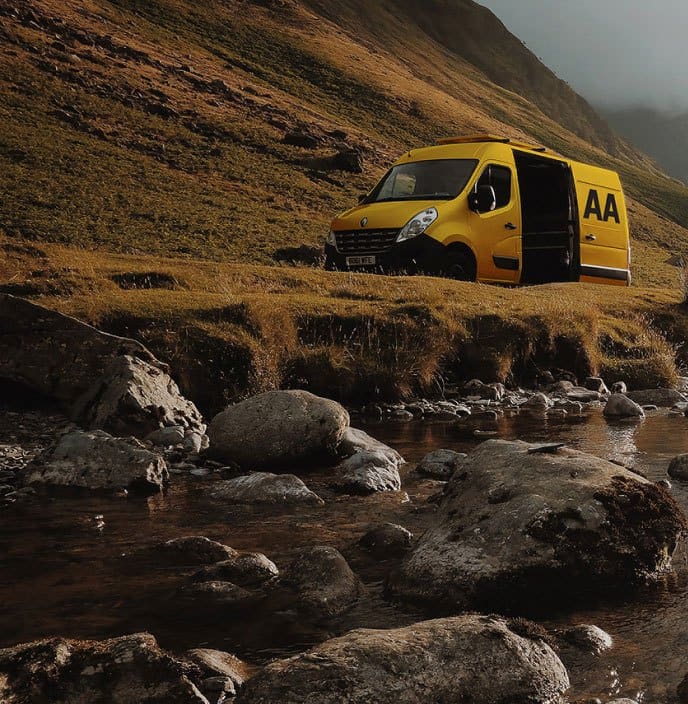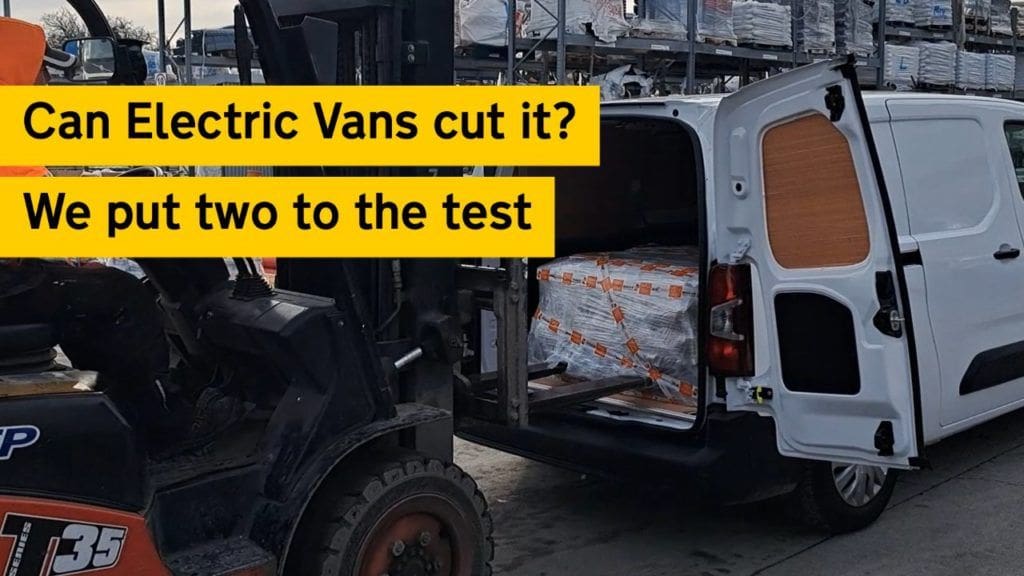Although demand is sky-rocketing and supply of electric vehicles can’t quite keep pace, there are still many people in Ireland that outright dismiss all types of electric vehicles. But what about vans? Here at AA Ireland, we got our hands on two all-electric vans for a week to try them out. We also took on an interesting challenge. We wanted to see what sort of difference it would make by loading up the vans with hundreds of kilos of cement mix!


Peugeot ePartner -VS- Maxus eDeliver3
It was a wet Thursday morning, with temperatures barely above freezing. We met up in a car park in Drogheda to have a look at each other’s vans. I was driving the Maxus eDeliver3. The brand is owned by SAIC Motor, a gigantic Chinese manufacturer of all types of vehicles. They now own the MG brand also. Starting at €35,000, the Maxus is a cheaper alternative to the other electric vans on the road. It has 4.8m3 cargo space, a payload capacity of around 900kgs and a usable battery capacity of 50kWh.
Paddy had the Peugeot ePartner Long Wheel Base. It features the same battery and drive-train that you find common across the Stellantis brands including the Citroen eC4, Peugeot e2008 and Opel Mokka e. It has just under 4.0m3 cargo space, a payload of around 750kg and a usable battery capacity of 45kWh.
Heading out…
The first part of our day’s challenge was to do a 73km loop of mixed driving with the vans completely unladen. We started off from Wogan’s Build Centre in Drogheda, where we would be loading up later that day. We headed around the outskirts of Drogheda and up to Collon in the Louth countryside. We then took some back roads on the way to Ardee that went up above 200m above sea level to see how the vans would fare on steep hills. With some bad traffic in Ardee, it was slow going before we finally reached our destination in Dundalk. It was a good chance to stretch the legs and swap vans before we headed back down the M1.


Both vans made the first round comfortably. The conditions were about the worst you would get in Ireland; with cold, damp roads and a few pockets of rain. We kept up a tidy speed and used the heating whenever we needed it. No hypermiling here! Frustratingly, the Peugeot doesn’t have an accurate read on the battery capacity, it is just an old-fashioned dial that makes it very hard to get a read closer than the nearest 5%. We estimated that it used 35%-40% of its capacity on the first loop. In contrast, we could tell that the Maxus used exactly 29%. It was first blow to the Maxus which was more efficient and used a good bit less of its battery for the same job.
Loading up…
We then popped down to the loading area at Wogan’s Build Centre. The staff had kindly packed up two pallets for us. Each had 500kgs of cement mix on standard Euro pallets. With a wide opening, the pallets were in the back of the vans in no time. You could see the difference in volume capacity between the vans, and you got the impression that the Maxus was built to be a little more suited for this rougher treatment.


500kgs extra weight onboard…
We hit the road again, doing the exact same speed on the exact same route. Temperatures had risen slightly and were a balmy 6 or 7 degrees Celsius. Paddy set off in the Peugeot, a little worried about having enough range to do the full loop. He had used 40% unladen that morning, and was now facing the same trip with 55% remaining to cover the extra weight in the back. The Maxus had 67% and felt well up to the task of getting back again.
We reached Dundalk around lunchtime, which gave us an excuse to grab some food and have a chat about how different the vans felt with the extra weight in the back. We were both very surprised at how well they handled it. There was no overly discernible difference in performance. You could tell they were a little slower to accelerate, and there was a bit more roll in the corners, especially with the Maxus on cheaper tyres. The benefit of the electric drivetrain stood out even more. There was no need to build up revs or catch the right gear. With EVs, you get all of the power on tap all of the time. This was especially noticeable on the steep drag up the hill beyond Collon. Both vans made their way smoothly to the top, each having well over 100hp to get the job done.
Does weight kill an EV’s range?
Arriving back in Wogan’s Build Centre in Drogheda, any range concerns we had were proven to be unfounded. Our worry that the weight in the back would destroy the battery was put at ease. The Maxus arrived back with 37% remaining. The Peugeot made it home comfortably. Although not fairing as well as the Maxus, it still had just over 20% remaining.
We were extremely surprised by the results. We expected the extra weight to really hurt the range, but in fact, we used less energy on the loop with the cement mix in the back! All factors were the same in terms of speed, route, and driving style. The biggest difference was the temperature. Batteries are a little like humans, we like a cosy temperature of around 20 to 30 degrees Celsius. We set out with very cold batteries that don’t work as efficiently at lower temperatures. This hurt the range in the morning. By the afternoon, the air had risen to about 7 degrees, but crucially the van’s batteries had also heated up during the 150km of driving.
Of course, the extra weight would have made the vans lose a little bit of range, but a much bigger factor is the temperatures that we were fighting. In an ideal world, they would have heat pumps and preconditioning technology such as in a Tesla. You programme the car to be ready for a certain time in the morning, and it draws power from the charger to heat up the cabin and battery on a cold morning.
Conclusions
We were hugely impressed by the vans. They were well up for the task and performed better than a lot of their Diesel equivalents. They were more comfortable to drive, and felt more at ease with the extra weight due to the benefits of having all of the power ready on tap. The problem might arise, however, if your day’s work was more than 200km. At that stage, some sort of top-up would be required and the vans are currently let down by the infrastructure. If you only rarely do more than 200km in a day, then they seem like a hugely compelling option.
Maxus eDeliver 3 or Peugeot ePartner – Which is better?
The Maxus is priced from €35,000, which is about €3,000 cheaper than the Peugeot. Paddy and I had a good chat at the end of the day, discussing which one we thought was best or was better value. In the end, we agreed that it was like the old saying: ‘horses for courses’. We both agreed that the Peugeot was the nicer cabin and nicer to drive. It was that bit more comfortable, with a nicer finish and quality all around. It felt more like a car than a van. On the other hand, the Maxus has that rugged, wipe-clean quality that suggests it would take a bit more punishment and wear.
In terms of the drive train, both vans perform well. The Maxus’s 90kW is well up for the task, even fully laden. We like that it seemed to have full access to all of its power. Even though the Peugeot has a beefier 100kW motor, it felt as if it was holding back a little. Having said that, it pulled strongly all the way up to 120 km/h on the motorway.
When it came to practicality, we both favoured the Maxus. With 4.8m3 of cargo space, it is comfortably bigger than the Peugeot. It has a payload of about 150kgs more than the Peugeot. It also has a good bit more range. Based on a week’s driving, we reckon that the Maxus has a real-world 40-50km or so more than the Peugeot. We think that those benefits would swing the buying decision for a lot of people toward the Maxus. However, the Peugeot is the more comfortable vehicle, and if you don’t need the space, range or payload, then is probably a better buy.
If you want to see all of the action in detail, just head over to our YouTube channel where there is a full 20-minute video charting the day’s events. Electric Van Challenge! | Maxus eDeliver3 -VS- Peugeot ePartner LWB | Reviewed & Tested! – YouTube
Of course, if you need to renew your van insurance, please do give us a call for a quote. We also have home and travel insurance to cover all of your needs! And don’t forget about our famous Breakdown Rescue, where we fix 9 out of 10 issues at the roadside.






